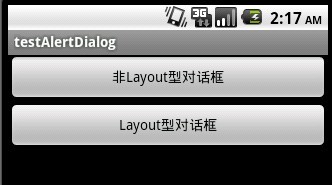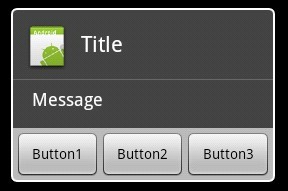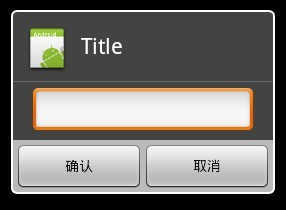
- android编程实现局部界面动态切换的方法
- android UI进阶之android中隐藏的layout 抽屉的使用方法
- Android M(6.x)使用OkHttp包解析和发送JSON请求的教程
- Android中创建快捷方式及删除快捷方式实现方法
- 详解Activity之singletast启动模式及如何使用intent传值
- Android编程中HTTP服务用法详解
- Android 开发随手笔记之使用摄像头拍照
- Android屏蔽EditText软键盘的方法
- android之计时器(Chronometer)的使用以及常用的方法
- Android TreeView效果实现方法(附demo源码下载)
- android基本控件ToggleButton&Switch使用指南
- Android实现TextView中文字链接的4种方式介绍及代码
- Android控件之Gallery用法实例分析
- 安装android开发环境原始版(windows版)
- Android自定义ViewGroup打造各种风格的SlidingMenu
- 实例讲解Android应用开发中Fragment生命周期的控制
- Android编程中Perferences的用法实例分析
- Android实现TextView两端对齐的方法
- [Android开发视频教学]01_16_SQLite使用方法
- Android自定义日历控件实例详解
- Android集成新浪微博第三方登录的方法
- [Java4Android]23_抽象类和抽象函数
- Android中执行java命令的方法及java代码执行并解析shell命令
- Android使用WebView播放flash的方法
- Android应用开发中View绘制的一些优化点解析
- Andriod arcgis保存Mapview为图片的实例代码
- 深入剖析Android系统中Service和IntentService的区别
- 完整的Android MVP开发之旅
- Android实现顶部导航菜单左右滑动效果
- Android WebView 上传文件支持全解析
Android入门之AlertDialog用法实例分析
作者:佚名 Android开发编辑:admin 更新时间:2022-07-23
本文实例讲述的是AlertDialog,这种对话框会经常遇到。AlertDialog跟WIN32开发中的Dialog不一样,AlertDialog是非阻塞的,而阻塞的对话框用的是PopupWindow。
先贴出该程序运行的截图:

main.xml的源码:
<?xml version="1.0" encoding="utf-8"?> <LinearLayout xmlns:android="http://schemas.android.com/apk/res/android" android:orientation="vertical" android:layout_width="fill_parent" android:layout_height="fill_parent" > <Button android:id="@+id/Button01" android:layout_height="wrap_content" android:text="非Layout型对话框" android:layout_width="fill_parent"></Button> <Button android:id="@+id/Button02" android:layout_height="wrap_content" android:text="Layout型对话框" android:layout_width="fill_parent"></Button><View android:id="@+id/View01" android:layout_width="wrap_content" android:layout_height="wrap_content"></View> </LinearLayout>
下图是非Layout型对话框,直接使用AlertDialog

下图是使用了Layout的对话框,可以自定义控件,实现更复杂的对话框

dialoglayout.xml的源码:
<?xml version="1.0" encoding="utf-8"?> <LinearLayout xmlns:android="http://schemas.android.com/apk/res/android" android:layout_width="fill_parent" android:layout_height="wrap_content" android:orientation="vertical"> <EditText android:layout_height="wrap_content" android:layout_width="fill_parent" android:layout_marginLeft="20dip" android:layout_marginRight="20dip" android:textAppearance="?android:attr/textAppearanceMedium" android:id="@+id/edtInput"/> </LinearLayout>
程序源码:
package com.testAlertDialog;
import android.app.Activity;
import android.app.AlertDialog;
import android.content.Context;
import android.content.DialogInterface;
import android.os.Bundle;
import android.view.Gravity;
import android.view.LayoutInflater;
import android.view.View;
import android.view.View.OnClickListener;
import android.widget.Button;
import android.widget.EditText;
import android.widget.PopupWindow;
public class testAlertDialog extends Activity {
Button btnShowDialog;
Button btnShowDialog_Layout;
/** Called when the activity is first created. */
@Override
public void onCreate(Bundle savedInstanceState) {
super.onCreate(savedInstanceState);
setContentView(R.layout.main);
//定义按钮
btnShowDialog=(Button)this.findViewById(R.id.Button01);
btnShowDialog.setOnClickListener(new ClickEvent());
btnShowDialog_Layout=(Button)this.findViewById(R.id.Button02);
btnShowDialog_Layout.setOnClickListener(new ClickEvent());
}
//统一处理按键事件
class ClickEvent implements OnClickListener{
@Override
public void onClick(View v) {
// TODO Auto-generated method stub
if(v==btnShowDialog)
showDialog(testAlertDialog.this);
else if(v==btnShowDialog_Layout)
showDialog_Layout(testAlertDialog.this);
}
}
//显示基本的AlertDialog
private void showDialog(Context context) {
AlertDialog.Builder builder = new AlertDialog.Builder(context);
builder.setIcon(R.drawable.icon);
builder.setTitle("Title");
builder.setMessage("Message");
builder.setPositiveButton("Button1",
new DialogInterface.OnClickListener() {
public void onClick(DialogInterface dialog, int whichButton) {
setTitle("点击了对话框上的Button1");
}
});
builder.setNeutralButton("Button2",
new DialogInterface.OnClickListener() {
public void onClick(DialogInterface dialog, int whichButton) {
setTitle("点击了对话框上的Button2");
}
});
builder.setNegativeButton("Button3",
new DialogInterface.OnClickListener() {
public void onClick(DialogInterface dialog, int whichButton) {
setTitle("点击了对话框上的Button3");
}
});
builder.show();
}
//显示基于Layout的AlertDialog
private void showDialog_Layout(Context context) {
LayoutInflater inflater = LayoutInflater.from(this);
final View textEntryView = inflater.inflate(
R.layout.dialoglayout, null);
final EditText edtInput=(EditText)textEntryView.findViewById(R.id.edtInput);
final AlertDialog.Builder builder = new AlertDialog.Builder(context);
builder.setCancelable(false);
builder.setIcon(R.drawable.icon);
builder.setTitle("Title");
builder.setView(textEntryView);
builder.setPositiveButton("确认",
new DialogInterface.OnClickListener() {
public void onClick(DialogInterface dialog, int whichButton) {
setTitle(edtInput.getText());
}
});
builder.setNegativeButton("取消",
new DialogInterface.OnClickListener() {
public void onClick(DialogInterface dialog, int whichButton) {
setTitle("");
}
});
builder.show();
}
}
- 上一篇文章: Android入门之PopupWindow用法实例解析
- 下一篇文章: Android入门之ListView应用解析(二)
- Android应用中内嵌SQLite数据库的基本操作指
- 仅4行代码实现Android快速文件下载
- Android使用Fragment打造万能页面切换框架
- android编程实现图片库的封装方法
- Android获取手机的版本号等信息的代码
- Android自定义控件实现边缘凹凸的卡劵效果
- Android编程中HTTP服务用法详解